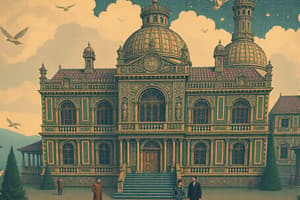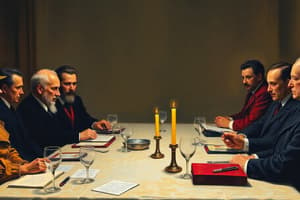Podcast
Questions and Answers
How did the Cold War contribute to conflicts in decolonized nations?
How did the Cold War contribute to conflicts in decolonized nations?
- By encouraging peaceful transitions of power.
- By creating a platform for international cooperation.
- By providing economic aid to stabilize their economies.
- By the US and USSR vying for influence, exacerbating internal conflicts. (correct)
What was the primary objective of American companies' influence in Latin America during the Cold War?
What was the primary objective of American companies' influence in Latin America during the Cold War?
- To promote fair labor practices and environmental protection.
- To foster democratic institutions and free elections.
- To protect their economic interests and prevent socialist governments from reclaiming land owned by them. (correct)
- To ensure equitable distribution of resources among the population.
In what way did the US and USSR compete for influence in Africa during the Cold War?
In what way did the US and USSR compete for influence in Africa during the Cold War?
- By establishing joint military bases to ensure regional security.
- By promoting cultural exchange programs to foster mutual understanding.
- By vying for economic and political influence to prevent governments from nationalizing private industries. (correct)
- By collaborating on infrastructure projects to boost economic development.
What was the significance of the Bandung Conference held in Indonesia in 1955?
What was the significance of the Bandung Conference held in Indonesia in 1955?
Which event led to the US halting arms supplies to the India-Pakistan region during the Cold War?
Which event led to the US halting arms supplies to the India-Pakistan region during the Cold War?
How did the Cold War powers influence the civil war between East and West Pakistan in the early 1970s?
How did the Cold War powers influence the civil war between East and West Pakistan in the early 1970s?
What was the United States' strategy in Afghanistan during the Cold War?
What was the United States' strategy in Afghanistan during the Cold War?
What long-term consequence resulted from the US strategy in Afghanistan during the Cold War?
What long-term consequence resulted from the US strategy in Afghanistan during the Cold War?
What action did Guatemalan leaders take in the 1950s that alarmed American businessmen?
What action did Guatemalan leaders take in the 1950s that alarmed American businessmen?
What was the outcome of the US intervention in Guatemala in 1954?
What was the outcome of the US intervention in Guatemala in 1954?
What event is known as the “Bay of Pigs” in Cuban history?
What event is known as the “Bay of Pigs” in Cuban history?
What was the Cuban Missile Crisis?
What was the Cuban Missile Crisis?
What was a significant social impact of Castro's policies in Cuba?
What was a significant social impact of Castro's policies in Cuba?
What was the main idea behind Pan-Africanism following World War Two?
What was the main idea behind Pan-Africanism following World War Two?
Who was Patrice Lumumba and what role did he play in the Congo during the Cold War?
Who was Patrice Lumumba and what role did he play in the Congo during the Cold War?
What led to the ousting and execution of Patrice Lumumba in the Congo?
What led to the ousting and execution of Patrice Lumumba in the Congo?
How did the Soviet Union attempt to maintain influence in Africa following Lumumba’s death?
How did the Soviet Union attempt to maintain influence in Africa following Lumumba’s death?
What was a significant long-term consequence of the Cold War in the Congo?
What was a significant long-term consequence of the Cold War in the Congo?
What actions did Egypt take during the Cold War to assert its independence?
What actions did Egypt take during the Cold War to assert its independence?
How did Egypt benefit from the competition between the US and USSR during the Cold War?
How did Egypt benefit from the competition between the US and USSR during the Cold War?
What was a defining characteristic of the Cold War beyond the direct conflict between the US and USSR?
What was a defining characteristic of the Cold War beyond the direct conflict between the US and USSR?
What impact did British colonial rule have on South Asia leading up to decolonization?
What impact did British colonial rule have on South Asia leading up to decolonization?
Why was British India partitioned in 1947?
Why was British India partitioned in 1947?
What was the primary reason for the civil war between East and West Pakistan?
What was the primary reason for the civil war between East and West Pakistan?
How did the civil war between East and West Pakistan impact multi-cultural harmony in South Asia?
How did the civil war between East and West Pakistan impact multi-cultural harmony in South Asia?
What characteristic of Afghanistan made it easy to resist foreign powers?
What characteristic of Afghanistan made it easy to resist foreign powers?
What event triggered the Soviet invasion of Afghanistan in the late 1970s?
What event triggered the Soviet invasion of Afghanistan in the late 1970s?
How did Spanish colonial rule affect Latin American communities?
How did Spanish colonial rule affect Latin American communities?
What impact did the United Fruit Company have on Guatemala in the mid-twentieth century?
What impact did the United Fruit Company have on Guatemala in the mid-twentieth century?
What actions did the US-backed Guatemalan rebels take after overthrowing the socialist government in 1954?
What actions did the US-backed Guatemalan rebels take after overthrowing the socialist government in 1954?
Flashcards
What was the Cold War?
What was the Cold War?
Ideological rivalry between the US and USSR, with indirect conflicts in smaller nations.
Cold War and Decolonization
Cold War and Decolonization
The US and USSR competed to influence newly independent countries with different government types.
US Intervention in Latin America
US Intervention in Latin America
In Latin America, the US intervened covertly to protect American business interests from socialist governments.
Cold War in Africa
Cold War in Africa
Signup and view all the flashcards
Partition of British India
Partition of British India
Signup and view all the flashcards
Bandung Conference (1955)
Bandung Conference (1955)
Signup and view all the flashcards
East-West Pakistan Civil War
East-West Pakistan Civil War
Signup and view all the flashcards
Soviet Invasion of Afghanistan
Soviet Invasion of Afghanistan
Signup and view all the flashcards
US Intervention in Guatemala
US Intervention in Guatemala
Signup and view all the flashcards
Bay of Pigs Invasion
Bay of Pigs Invasion
Signup and view all the flashcards
Cuban Missile Crisis
Cuban Missile Crisis
Signup and view all the flashcards
Pan-Africanism
Pan-Africanism
Signup and view all the flashcards
Death of Patrice Lumumba
Death of Patrice Lumumba
Signup and view all the flashcards
Study Notes
- The Cold War was characterized by ideological rivalry between the US and USSR, leading to violence and tension in smaller, newer nations.
Decolonization and the Cold War
- The US and USSR competed to influence newly independent governments in Asia, Africa, and Latin America.
- In Southeast Asia, civil conflicts were sponsored by either the US or USSR.
- In Latin America, American companies influenced government and economics, while Soviet movements emerged.
- The US military intervened covertly to protect American interests and prevent socialist/communist governments from reclaiming American-owned land.
- In Africa, the US and USSR competed for economic and political influence, with the US aiming to prevent governments from nationalizing private industries.
- Newly decolonized nations faced intrusion from American and Soviet interests.
The Cold War in Asia
- China became communist in 1949.
- Decolonization in South Asia led to violence between Hindus, Muslims, and Sikhs, resulting in over a million deaths.
- In 1947, British India was partitioned into Hindu-majority India and Muslim-majority Pakistan to end the civil war.
- Pakistan joined a US-led trade alliance in 1954 to contain communism, while India promoted non-alignment at the 1955 Bandung Conference.
- The Cold War escalated along the India-Pakistan border over Kashmir in 1965.
- After the UN called for diplomacy, the US halted arms, favoring India, which maintained control of Kashmir after a ceasefire.
- A civil war in Pakistan in the early 1970s involved India, the US, and the USSR.
- West Pakistan forced Urdu on Bangla-speaking East Pakistanis, who sought to create their nation.
- The US supported West Pakistan, while India and the USSR supported East Pakistan.
- East Pakistan gained independence as Bangladesh in 1971 with India's help.
- Violence between Muslims and Hindus increased in South Asia.
- In Afghanistan, the arbitrary border divided communities, but the terrain made it easy to resist foreign powers.
- In the late 1970s, the USSR invaded after communist sympathizers failed to unify Afghanistan, leading to the US funding Islamic jihadists.
- The conflict lasted almost a decade, weakening the USSR and contributing to the rise of Islamic fundamentalists.
The Cold War in Latin America and the Caribbean
- Latin American communities were divided along ethnic and economic lines after three centuries of Spanish colonial rule.
- In Guatemala, indigenous Mayas were marginalized as the United Fruit Company became the largest landowner, forcing local banana farmers out of business.
- In the 1940s, socialist leaders sought equitable distribution of resources.
- In the 1950s, farmland was given back to poor people, and workers were allowed to organize for better wages.
- American businessmen convinced the US to overthrow the socialist government, fearing the loss of land and the spread of communism.
- In 1954, the CIA helped Guatemalan rebels overthrow the government and install an anticommunist leader who returned land to the United Fruit Company.
- Emboldened by its success, the US intervened in Costa Rica and Honduras to protect American-owned banana plantations.
- The USSR supported Fidel Castro’s communist government in Cuba, which nationalized industries after taking power in 1959.
- The US authorized the CIA to work with Cuban resistance groups, but a coup attempt was thwarted in 1961.
- The "Bay of Pigs" was a high-profile embarrassment for the US.
- Cuba harbored Soviet nuclear missiles 90 miles from Florida in 1962, leading to the Cuban Missile Crisis.
- Nuclear war was narrowly avoided.
- The state promotes education and health, so many residents of neighboring countries travel to Cuba for medical care.
- Cuba remains a communist country today.
The Cold War in Africa
- Communist and socialist ideas influenced decolonizing populations in Africa.
- There was strong anti-imperial and pan-African sentiment after World War Two.
- Pan-Africanists connected at international conferences to exchange cultural and political ideas.
- In the Belgian Congo, Patrice Lumumba, a pan-Africanist with communist sympathies, became the first Prime Minister in 1960.
- The US and Belgium wanted to maintain foreign businesses in resource-rich Katanga.
- Lumumba turned to the Soviet Union for assistance, leading to his capture and execution with the help of Belgian and US intelligence in 1961.
- The period of Cold War tensions altered life in the Congo dramatically, so in Moscow 1961 the Soviet Union created the Patrice Lumumba University to educate Third World students and attract them to communism.
- A strong military dictatorship emerged in 1965, with a legacy of anticommunism, corruption, and authoritarian rule.
- Egypt also ended Western alliances in the 1950s and 1960s, with nationalists taking control of the Suez Canal.
- Egyptian leaders engaged in socialist projects and accepted military aid from the Soviets.
- The government received economic assistance from both superpowers for projects like the Aswan Dam.
- Egypt maintained general neutrality in the Cold War until the 1970s when it strengthened ties to the US.
Studying That Suits You
Use AI to generate personalized quizzes and flashcards to suit your learning preferences.




